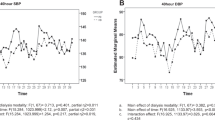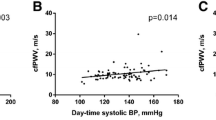Abstract
Ambulatory blood pressure monitoring has been steadily growing in popularity as equipment becomes more accurate, affordable, and patient-friendly. In addition, software packages are more powerful and physician-customizable, and more physicians are accepting of ambulatory blood pressure monitoring’ advantages. Summarizing the studies that deal mainly with hemodialysis patients, there are clear advantages to using more than isolated pre- and posthemodialysis blood pressure readings. If enough predialysis blood pressure readings are taken and averaged, this is a reasonable guide to endorgan damage (ie, left ventricular hypertrophy). Home and ambulatory blood pressure-derived values are complementary, and only this approach can discern any further contribution from diurnal blood pressure elevation. The crosssectional association between blood pressure and end-organ damage is very weak in end-stage renal disease patients if the blood pressure values are “casual,” but the relationship is much stronger when ambulatory blood pressure monitoring-derived measurements are used. One prospective study clearly linked the sustained loss of diurnal blood pressure fall with sleep with progressive left ventricular dilatation. Loss of circadian variation in blood pressure is associated with an increased mortality rate for dialysis patients and for diabetic patients, regardless of diabetes type. The combination of nondipping in renal impairment leads to a high mortality rate. Much more work is needed to dissect out the causes for abnormal diurnal blood pressure rhythm and attempt to modulate this parameter. Obstructive sleep apnea may be a promising target for intervention.
Similar content being viewed by others
References and Recommended Reading
Pickering TG: Blood pressure variability and ambulatory monitoring. Curr Opin Nephrol Hypertens 1993, 2:380–385.
Staessen JA, Bieniaszewski L, O’Brien ET, et al.: Nocturnal blood pressure fall on ambulatory monitoring in a large international databse. The “Ad hoc” working group. Hypertension 1997, 29:30–39.
Hansen HP, Rossing P, Tarnow L, et al.: Circadian rhythm of arterial blood pressure and albuminuria in diabetic nephropathy. Kidney Int 1996, 50:579–585.
Timio M, Venanzi S, Lolli S, et al.: “Non-dipper” hypertensive patients and progressive renal insufficiency: a 3-year longitudinal study. Clin Nephrol 1995, 43:382–387.
Covic A, Goldsmith DJ: Ambulatory blood pressure monitoring in nephrology: focus on BP variability. J Nephrol 1999, 12:220–229.
Zoccali C, Benedetto FA, Mallamaci F, et al.: Left ventricular hypertrophy and nocturnal hypoxemia in hemodialysis patients. J Hypertens 2001, 19:287–293.
Zoccali C, Mallamaci F, Tripepi G, Benedetto FA: Autonomic neuropathy is linked to nocturnal hypoxaemia and to concentric hypertrophy and remodelling in dialysis patients. Nephrol Dial Transplant 2001, 16:70–77. This study links the importance of obstructive sleep apnea and nocturnal hypoxemia with sympathetic arousal/drive, and consequent effects on left ventricular structure.
Verdecchia P, Palatini P, Schillaci G, et al.: Independent predictors of isolated clinic (’white-coat’) hypertension. J Hypertens 2001, 19:1015–1020.
Zoccali C, Mallamaci F, Tripepi G, et al.: Prediction of left ventricular geometry by clinic, pre-dialysis and 24-h ambulatory BP monitoring in hemodialysis patients: CREED investigators. J Hypertens 1999, 17:1751–1758.
Cannella G, Paoletti E, Ravera G, et al.: Inadequate diagnosis and therapy of arterial hypertension as causes of left ventricular hypertrophy in uremic dialysis patients. Kidney Int 2000, 58:260–268.
Cuspidi C, Macca G, Sampieri L, et al.: Target organ damage and non-dipping pattern defined by two sessions of ambulatory blood pressure monitoring in recently diagnosed essential hypertensive patients. J Hypertens 19:1539–1545.
Agarwal R: Role of home blood pressure monitoring in hemodialysis patients. Am J Kidney Dis 2000, 33:682–687. This study carefully examines the relationship between BP measured in different ways and the left ventricular consequences. It makes the clear point that only with proper attention to detail can a successful assessment of BP be achieved, and that this is the first step toward targetted intervention.
Galiatsou E, Morris ST, Jardine AG, et al.: Cardiac and vascular abnormalities in renal transplant patients: differential effects of cyclosporin and azathioprine. J Nephrol 2000, 13:185–192.
Peixoto AJ, Santos SF, Mendes RB, et al.: Reproducibility of ambulatory blood pressure monitoring in hemodialysis patients. Am J Kidney Dis 2000, 36:983–990.
Covic A, Goldsmith DJ, Covic M: Reduced blood pressure diurnal variability as a risk factor for progressive left ventricular dilatation in hemodialysis patients. Am J Kidney Dis 2000, 35:617–623. This is the first attempt to follow ambulatory BP outcomes prospectively with repeated cross-sectional analysis of the link between ambulatory BP and left ventricular geometry. This paper established that the majority of hemodialysis patients retained their diurnal rhythmicity over three consecutive ABPM sessions, and that persistent nondippers had heavier (more dilated) left ventricle.
Farmer CK, Goldsmith DJ, Cox J, et al.: An investigation of the effect of advancing uraemia, renal replacement therapy and renal transplantation on blood pressure diurnal variability. Nephrol Dial Transplant 1997, 12:2301–2307.
Fagugli RM, Reboldi G, Quintaliani G, et al.: Short daily hemodialysis: blood pressure control and left ventricular mass reduction in hypertensive hemodialysis patients. Am J Kidney Dis 2001, 38:371–376.
Narita I, Okada M, Omori S, et al.: The circadian blood pressure rhythm in non-diabetic hemodialysis patients. Hypertens Res 2001, 24:111–117.
Converse RLJ, Jacobsen TN, Toto RD, et al.: Sympathetic overactivity in patients with chronic renal failure. N Engl J Med 1992, 327:1912–1918.
Vita G, Princi P, Savica V, et al.: Uremic autonomic dysfunction evaluated by pattern recognition analysis. Clin Nephrol 1991, 36:290–293.
Zoccali C, Benedetto FA, Tripepi G, et al.: Nocturnal hypoxaemia, night-day arterial pressure changes and left ventricular geometry in dialysis patients. Kidney Int 1998, 53:1078–1084.
de la Sierra, Bragulat E, Sierra C, et al.: Microalbuminuria in essential hypertension: clinical and biochemical profile. Br J Biomed Sci 2000, 57:287–291.
Boulatov VA, Stenehjem A, Os I: Association between albumin:creatinine ratio and 24-hour ambulatory blood pressure in essential hypertension. Am J Hypertens 2001, 14:338–344.
Poulsen PL, Ebbehoj E, Nosadini R, et al.: Early ACE-i intervention in microalbuminuric patients with type 1 diabetes: effects on albumin excretion, 24 h ambulatory blood pressure, and renal function. Diabetes Metab 2001, 27:123–128.
Poulsen PL, Bek T, Ebbehoj E, et al.: 24-h ambulatory blood pressure and retinopathy in normoalbuminuric IDDM patients. Diabetologia 1998, 41:105–110.
Csiky B, Kovacs T, Wagner L, et al.: Ambulatory blood pressure monitoring and progression in patients with IgA nephropathy. Nephrol Dial Transplant 1999, 14:86–90. A prospective study showing faster progression of IgA nephropathy in patients with blunted diurnal BP rhythm despite similar BP values by day.
Szelestei T, Kovacs T, Barta J, Nagy J: Circadian blood pressure changes and cardiac abnormalities in IgA nephropathy. Am J Nephrol 1999, 19:546–551.
Jacobi J, Rockstroh J, John S, et al.: Prospective analysis of the value of 24-hour ambulatory blood pressure on renal function after kidney transplantation. Transplantation 2000, 70:819–827.
Amar J, Vernier I, Rossignol E, et al.: Nocturnal blood pressure and 24-hour pulse pressure are potent indicators of mortality in hemodialysis patients. Kidney Int 2000, 57:2485–2491. Patients with abnormal diurnal BP rhythm had a greater mortality than those hemodialysis patients with preserved diurnal BP rhythmicity.
Sturrock ND, George E, Pound N, et al.: Non-dipping circadian blood pressure and renal impairment are associated with increased mortality in diabetes mellitus. Diabetes Med 2000, 17:360–364.
White WB, Mansoor GA, Pickering TG, et al.: Differential effects of morning and evening dosing of nisoldipine ER on circadian blood pressure and heart rate. Am J Hypertens 1999, 12:806–814.
Ebata H, Hojo Y, Ikeda U, et al.: Differential effects of an alpha 1-blocker (doxazosin) on diurnal blood pressure variation in dipper and non-dipper type hypertension. Hypertens Res 1995, 18:125–130.
Kario K, Schwartz JE, Pickering TG: Changes of nocturnal blood pressure dipping status in hypertensives by nighttime dosing of alpha-adrenergic blocker, doxazosin: results from the HALT study. Hypertension 2000, 35:787–794.
Author information
Authors and Affiliations
Rights and permissions
About this article
Cite this article
Covic, A., Goldsmith, D.J.A. Ambulatory blood pressure measurement in the renal patient. Current Science Inc 4, 369–376 (2002). https://doi.org/10.1007/s11906-002-0066-6
Issue Date:
DOI: https://doi.org/10.1007/s11906-002-0066-6




